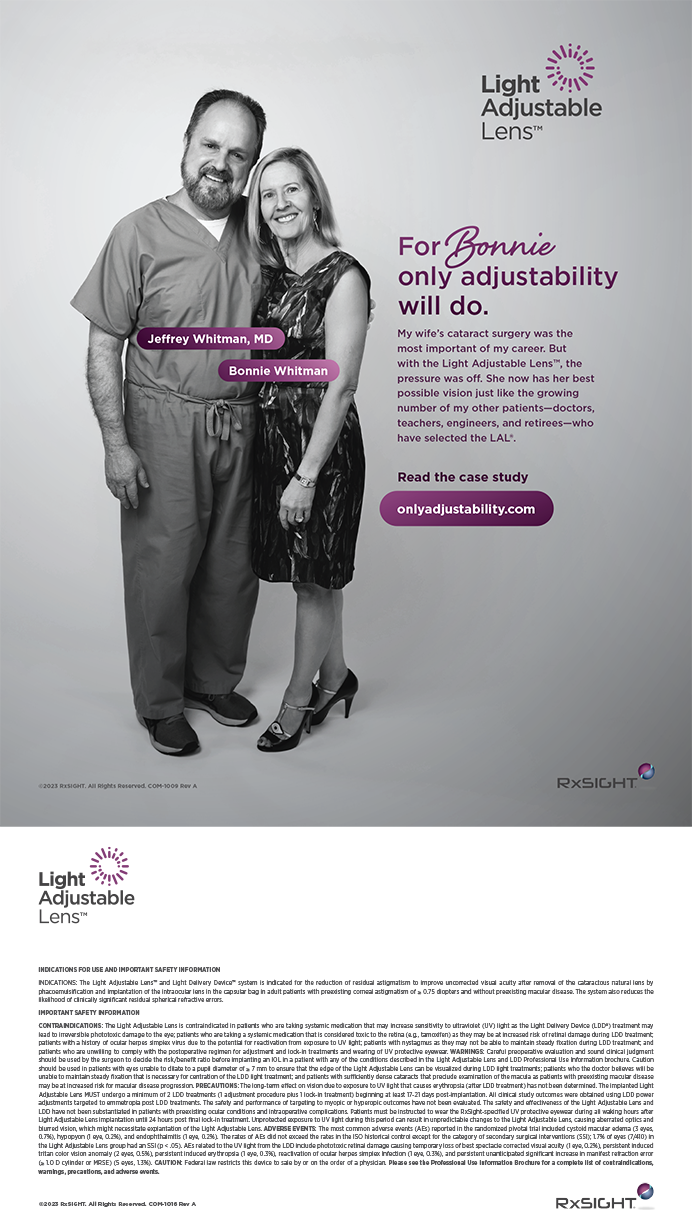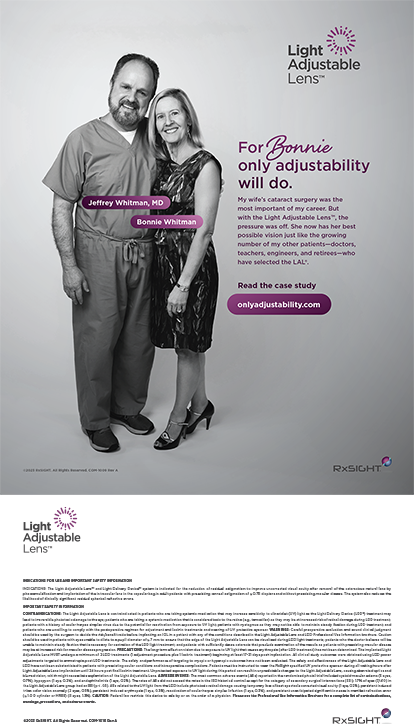
In 2019, when I was looking forward to 2020, I imagined a year filled with marketing campaigns tying the year to the result of 20/20 UCVA after LASIK. The global pandemic completely upended that naïve prediction. The year 2020 was the most unusual and challenging I have experienced in my 25 years as a refractive surgeon.
PRIOR TURMOIL
The past 20 years have included plenty of turmoil for the refractive surgery industry. Refractive surgery is elective, paid for privately with discretionary spending. Global events and major economic changes therefore affect overall procedural volume. The bursting dot-com bubble in the late 1990s and the terrorist attacks on September 11, 2001, precipitated significant drops in procedural volume that lasted months.
The field experienced a revival from 2001 to 2008 as mainstream acceptance of refractive surgery increased. Courses on LASIK at the annual ASCRS symposium were so popular during this period that monitors were installed in the hallways outside the lecture room to accommodate all of the attendees interested in these learning opportunities.
The subprime mortgage crisis hit the United States and caused a dramatic decline in refractive surgery volume in the second half of 2008 that ultimately led The Laser Eye Centers (TLC) to file for bankruptcy—a humbling experience for everyone involved. This drop in volume was more pronounced and lasted longer than earlier declines. Many refractive surgeons returned to the more stable and consistent field of cataract surgery, which had been invigorated by the advent of specialty IOLs and the use of a femtosecond laser and resulted in the field’s becoming more lucrative than before. Some surgeons who had performed refractive procedures exclusively even retrained in cataract surgery in order to reenter that market. I briefly considered taking the same route by working with a busy cataract surgery practice, but I found that refractive surgery was my true passion.
In 2009, I wrote an article for CRST that described the effects of the subprime mortgage crisis on refractive surgery and provided my suggestions for addressing the resultant challenges (click here to read the article).1 To reduce costs, I advised reducing direct-to-consumer marketing and focusing on word-of-mouth and comanagement referral sources. I suggested reducing staff hours to a 4-day-a-week schedule with voluntary unpaid days off. I also recommended fine-tuning practices to prepare for a rebound in LASIK volume from the pent-up demand after the financial crisis ended. Additional changes that I suggested included updating older technology, reviewing the business metrics of consultation-to-conversion ratios, and increasing patient accessibility by instituting evening clinic hours and Saturday clinics.
In retrospect, these changes were helpful, and most of them are still in place. The revival of the refractive industry, however, was much slower than I had anticipated. Although refractive surgery volume recovered during the next decade, year-over-year growth was in the single digits.
THE COVID-19 PANDEMIC
Fast forward to March 2020, when the effects of the global pandemic hit the refractive surgery industry. Suddenly, all elective procedures across the country were cancelled to optimize hospital access and physician availability for the health crisis. For a refractive surgery company, this change was devastating because it represented a complete loss of revenue. TLC and its parent company Vision Group Holding (VGH), which also owned The Laser Vision Institute, filed for bankruptcy.
Initial steps. Once we resumed performing refractive procedures in June 2020, we faced a new set of challenges. We needed to adhere to new safety parameters, including screening patients for symptoms of COVID-19 and, in some states, performing COVID-19 testing. We also implemented guidelines such as physical distancing in the office, the use of masks and sometimes goggles, and temperature checks. Rooms were sterilized after each use. Prepayments were encouraged to reduced patients’ time in the office. Waiting rooms were closed, and clinic access was restricted to patients only.
One of the more surprising challenges we encountered was the slower pace of the procedures. Initially, this was owing to enhanced cleaning and a lower number of patients in the clinic because of the requirement for physical distancing.
Once we adjusted to the changes, fresh challenges emerged. Each staff member had a unique response to the pandemic. Most were comfortable with the new safety protocols, but some had an increased level of concern, sometimes because of an underlying health issue that put them or a family member at increased risk of COVID-19. The net effect of this concern was a much more cautious and reserved approach that resulted in a slower pace in the clinic.
To address the staff’s concerns and to try to restore my regular surgical pace, I was forced to revise my practice patterns. For the past 25 years, our center’s optometrist had checked patients after their procedure before they left the clinic. Because this final check required an examination lane and the optometrist, it tied up resources limited by COVID-19 protocols. I therefore incorporated the final postoperative check into my procedure. At the conclusion of surgery, I use the slit lamp on the excimer laser (WaveLight EX500, Alcon) to examine the eyes. Not only has this change increased efficiency, but it has also improved outcomes because any minor imperfection or small amount of interface debris can be easily and quickly addressed while the patient is under the laser. Previously, patients would have been sent back to the procedure room. I have also started walking patients to the laser room and out again, which was previously done by my staff.
With these changes, I lead my staff by example. I am demonstrating a willingness to adopt new protocols and put in the extra work required. These changes also allow me to provide a personal touch such as by making supportive comments as I walk with patients.
The next phase. By September 2020, 3 months after we established the new protocols and adjustments for our practice, our prepandemic surgical pace had been restored. Then, suddenly, everyone wanted LASIK. There have been many opinions about the reasons for this wave of interest, including more discretionary income from stimulus checks and a lack of vacations, travel, and dining out; more free time due to working from home instead of commuting to an office; a greater focus on self when isolated from others; and fogging of glasses while wearing a mask.
Fluctuations in procedural volume are best monitored by laser companies because they can track procedures across a wide range of users. Procedural volume was down 10% overall for 2020 compared to 2019; this downturn includes 2 months of inactivity during 2020. During the fourth quarter of 2020, however, procedural volume was up about 15% compared to the same period in 2019. Procedural volume during the first quarter of 2021 is even more remarkable: There was approximately 30% growth compared to the same period in 2020. The second quarter of 2021 seems to be following a similar growth rate.2
The growth in procedural volume experienced at TLC has been even greater. VGH, the holding company for TLC and The Laser Vision Institute, was acquired in a bankruptcy acquisition by Kismet New Vision Holdings, which owns LASIKPlus. The company-centric strategies of VGH have been replaced by a patient-centered strategy. Local and regional control of operations was replaced by centralized control. The net result of these fundamental changes was an increase in the number of consultations that were performed, producing a dramatic increase in the number of procedures performed. Overall, my personal procedural volume increased by more than 50% in the first quarter of 2021 compared to the same period in 2020. This surpassed my previous record for peak procedural volume in the first quarter of 2008.
The increase in procedural volume has been great news for the refractive surgery industry, but it has been hard on our doctors and staff. Staff numbers were already reduced from before the pandemic because some people chose not to return to work. Worries about the pandemic, moreover, bred anxiety in the staff members who remained. The sudden increase in volume in the first quarter of 2021 resulted in long, busy consultation and surgical days. Unfortunately, all of these changes in such a short time have led some of my long-term dedicated and dependable employees to resign.
CONCLUSION
The past year has been a wild ride. My center went from zero procedures in April and May 2020 to a 150% increase in procedural volume during the first quarter of 2021. This dramatic uptick in refractive surgery volume, however, is likely to subside. Summer and fall are traditionally less popular times for refractive surgery. Moreover, as the vaccination rate in the United States surpasses 50%, concerns about the pandemic will begin to ease, and a gradual shift toward normality should occur. This will likely reduce or remove some of the pandemic-related drivers of LASIK volume.
I expect the current boom in refractive surgery to subside by the end of 2021, but after a year of surprises, who knows for sure what will happen next?
Revisit Dr. Probst’s thoughts on addressing the challenges in refractive surgery that were brought on by the effects the subprime mortgage crisis in 2008 to 2009. Archived from the January 2009 issue of CRST.
1. Probst LE. New challenges for refractive surgery in 2009. Cataract & Refractive Surgery Today. January 2009. Accessed May 6, 2021. https://crstoday.com/articles/2009-jan/crst0109_11-php
2. Refractive Surgery Council reports nearly 30% rise in laser vision correction procedures year over year. Refractive Surgery Council. April 30, 2021. Accessed May 10, 2021. https://eyewire.news/articles/refractive-surgery-council-reports-nearly-30-rise-in-laser-vision-correction-procedures-year-over-year




